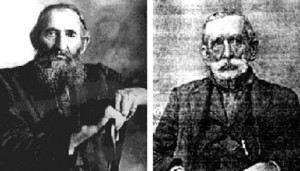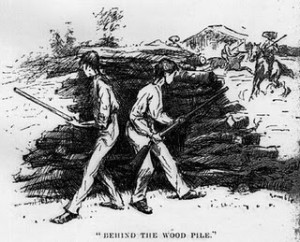- Attached to the essay "Bellicose Bambini"
What are the preconditions of a blood feud?
Posted November 4, 2011 10:44 am On the right, Randolph McCoy, whose brother Harmon’s death was blamed on Jim Vance, the uncle of the man on the left, Devil Anse Hatfield. Their feud, at the end of the 19th century, in the back country of West Virginia and Kentucky, though lasting only13 years, entered American folklore as an example of over the top, irrational infighting. The feud was fueled by the Hatfields fighting for the Confederacy and the McCoy’s for the Union; by the matter of a stolen pig; and by star-crossed lovers from the two families whose affair ended badly.
On the right, Randolph McCoy, whose brother Harmon’s death was blamed on Jim Vance, the uncle of the man on the left, Devil Anse Hatfield. Their feud, at the end of the 19th century, in the back country of West Virginia and Kentucky, though lasting only13 years, entered American folklore as an example of over the top, irrational infighting. The feud was fueled by the Hatfields fighting for the Confederacy and the McCoy’s for the Union; by the matter of a stolen pig; and by star-crossed lovers from the two families whose affair ended badly.
The feud may have inspired chapter XIX in “Huckleberry Finn,” in which Huckleberry falls in with the Grangerford family who are engaged in a 30-year blood feud with the Sheperdsons.  The chapter feels endless, irritating the reader and thus perhaps driving home the irrationality of circular revenge killing. As the Hatfield and McCoy feud took place between 1878 and 1896, and Twain published his novel in 1884, it is possible that the feuding Appalachians found their way into a great American novel. Is this believed to be the case by people in the field?
The chapter feels endless, irritating the reader and thus perhaps driving home the irrationality of circular revenge killing. As the Hatfield and McCoy feud took place between 1878 and 1896, and Twain published his novel in 1884, it is possible that the feuding Appalachians found their way into a great American novel. Is this believed to be the case by people in the field?
A recent discovery may shed light on the famous feud: an inherited disease, Von Hippel disease, runs in the McCoy line and predisposes the sufferers to shortness of temper and impulsivity.
But short of a genetic proclivity, why are some conflicts taken up by whole families and carried on for generations (like the Montagues and Capulets)?
share
 site feed
site feed



Elizabeth Marcus January 6, 2012 at 4:21 pm
Here is another off-line response, one from Robin Bates, professor of English at St. Mary’s College of Maryland, and author of the wonderful website, http://www.betterlivingthroughbeowulf.com/
“One of the most powerful literary images of blood feuds that I know is Grendel’s Mother in the 9th century Anglo-Saxon epic Beowulf. I think there is a very logical explanation as to how blood feuds operate in the poem. Grendel, a
figure who is wracked by jealousy, takes his anger out on others, and once someone has been killed (I have theories about why Grendel is killed), the stage is set for a potential blood feud. The fact that the monster is depicted as a woman and that she lives in an underwater castle shows just how deep sorrow
goes. Anglo-Saxon warriors can’t imagine anything more fierce that a mother’s rage over losing a child and so she becomes the face of the emotion. In a blood feud, one doesn’t have to single out the particular person who killed one’s
loved one, and Grendel’s Mother picks out, not Beowulf, but Aeschere, King Hrothgar’s best friend.
Just how socially disruptive blood feuds were is indicated by how distraught Hrothgar is. He is prepared to give up, and it takes Beowulf to rouse him and advocate a little “revenge therapy”–i.e., go kill the killer. But while this
seems to provide some relief, ultimately it proves to be empty, as we see at the end of the poem. There, Beowulf looks back over his own life and sees a long string of tit-for-tat deaths. That he is in danger of being consumed by a
dragon at that point is a metaphor, I believe, for the depression that threatens to consume him.
In Anglo-Saxon England, there were several ways that people tried to end blood feuds. One was to pay blood money. But this didn’t work if emotions went deep enough, and it is interesting that the Grendel family refuses to accept such
money.
Another way is through diplomatic marriage. But in “Beowulf” we are given an instances of where such marriages fail spectacularly, including the case of the
wife of the Frisian king Finn, who is married to patch over a quarrel, sees renewed hostilities, and watches as both her Frisian son and her Danish brother are killed fighting each other.
I’m currently writing a book (How Beowulf Can Save America: An Epic Hero’s Guide to Defeating the Politics of Rage) and am interested in how one handles these kinds of extreme emotions (versions of which we are seeing in America today).
Beowulf does so by leaping into the lake of Grendel’s Mother and confronting the sorrow right on. But in the end, he has to invoke something beyond self, a giant sword that symbolizes the warrior ethos. Because otherwise, we can’t see anything beyond our own hurt and wish to visit that hurt on those we hold responsible.
eliz January 4, 2012 at 9:05 am
I asked Ben Click, Chair of the English Department of St. Mary’s College of Maryland, for the academic consensus on the origin of Mark Twain’s depiction of feuding. Here is his off-line response:
In Twain’s classic, the Grangerford-Shepardson feud represents a characteristic aspect of American frontier life — rival families, often farmers versus herders, with vendettas against one another. Cain, the granger and Abel, the shepherd also represent the biblical prototypes of this kind of feud. Some scholars suggest that Twain may have been thinking of the famous Hatfields and McCoys of
West Virginia, but more other scholars convincingly identify Twain’s source as the feud between the Darnalls and Watsons. Twain had first discussed feuds in his travel book, Life on the Mississippi, suggesting that the Kentucky-Tennessee border was the area of the South where feuds “flourished more briskly” than anywhere else. When the veracity of such feuding was questioned, Twain responded by saying that he had come very close to personally witnessing such a
conflict. Twain’s own account in Huck Finn has been verified by newspaper accounts of the time.
My summary above is a shortened version of Neal Patrick Hearn’s notes in
The Annotated Huckleberry Finn (189-91).